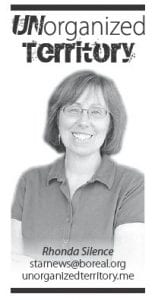As I write this column, members of the Cook County DFL are preparing for an interesting public meeting on Saturday, January 30: Everything you wanted to know about caucuses, but were afraid to ask.
The notice of the presentation was in last week’s News-Herald and posters were up all over the county. It was hosted by the Cook County DFL, but I hope a lot of people attended, Democrats, Republicans, Independents, Greens or undecided voters. No matter your political affiliation, there is a political caucus to attend and the process is similar for all.
And for many, the concept of caucuses and the part they play in our political process is a bit bewildering. I will admit that before I started working at the local newspaper, I never thought about taking part in caucuses. I had no clue what went on at a caucus and that I could—and should—take part.
Since working at the newspaper, I’ve attended enough caucuses—both Republican and Democrat—to now understand how it works and what to expect. But I still remember the first caucus I attended, a DFL caucus at the Cook County Senior Center.
I forget how long ago it was, but I do remember that Joanne Hart of Grand Portage was one of the caucus facilitators. She was lively and welcoming and made everyone feel comfortable as they signed in and then began discussion of the political topics and resolution making.
Since then I’ve attended more than a dozen caucuses and all have been interesting. It is remarkable to see long-time caucus attendees with ideas and resolutions in hand, ready to go. And it is exciting to watch firsttime attendees realize that they have a voice, that they can fill out a slip of paper with an idea on how to change our government.
Often resolutions brought forward are already covered by language in the party platform. Those are quickly set aside so time can be spent discussing new ideas, possible additions or changes to the platform. Cynics may say that the political parties are entrenched in their platforms and nothing can change that. Changes to the platforms are made at national conventions, so there are some who believe resolutions made at the local level have little impact.
But if more and more citizens attend caucuses and reach consensus on an issue, momentum to make a change could grow. The resolutions introduced at precinct caucuses, if approved, get sent on to county conventions and then on to the state convention. Delegates from the state convention travel to the national convention and there they can lobby one another for modification to various parts of the party platform—its planks.
Party platforms cover issues ranging from immigration reform, health care, energy, abortion, taxes, the management of social security and more. It is true that the party platforms change little from year to year, but it has been known to happen. For example, in recent years the Democratic Party agreed that its platform should be amended to address concerns about the North American Free Trade Agreement (NAFTA) and to call for more citizen service through an expansion of the AmeriCorps and Peace Corps programs. The Republican Party modified its platform to seek increases in the age of eligibility for Medicare and Social Security because of increased longevity and to curtail the power of the Environmental Protection Agency.
Once the platform is set it becomes the manifesto for the candidates elected to represent us. DFL representatives adhere to the Democratic platform; GOP to the Republican platform. That somewhat explains the gridlock that affects our state and national legislatures.
Think of the power if citizens came forward with the same ideas from both parties. I know, it is unlikely on most of the tenets of the respective party platforms. However, after the last caucus, fellow reporter Brian Larsen and I compared notes. We checked off the lists of the resolutions introduced and sighed over the vast divide between the parties. Until we reached one resolution that had been offered by caucus attendees at both the Republican and the Democratic caucuses.
Citizens of both persuasions asked their party to forward a resolution to the county, then state, then national convention, asking that the people who represent us— our congressmen, our senators, and the president—fall under the same health care laws as the average citizen, instead of having access to a gold standard federal health plan. I like the idea. I think it is only fair that those making the laws fall under the same mandates as the rest of us.
But even more than the fact that I like the proposal, I was delighted to see consensus among participants at both caucuses. Unfortunately I haven’t seen this proposal added to either the Republican or Democratic platform yet, but I have hope. I would love to see this brought forward again and again, until our legislative representatives listen.
Even better, I would like to see citizens work together on other issues to try to bridge the gaps between political parties. It seems that our entrenched legislators can’t do it. Maybe voters can. And it all starts at the basic political unit, the precinct caucus. Mark your calendar to attend on March 1, 2016. Change could happen, but we won’t know unless we try.
I have seen the times when the
grassroots has moved the Congress.
We listen way more often to our
constituents than the lobbyists.
John Linder



Loading Comments